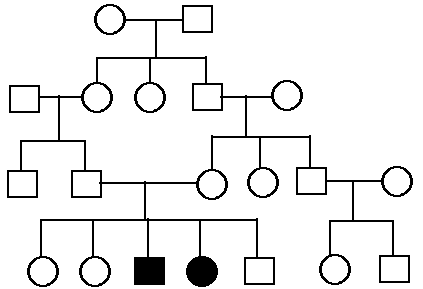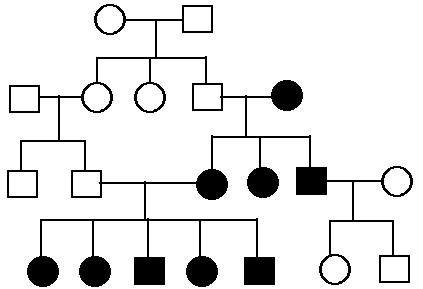|
| 1 |
A boy is born with
an extra finger on one hand. Extra digits are known to be common in members
of the father's extended family, but not the mother's. The boy's two sisters
have normal fingers. What is the most likely explanation? |
|
|
|
X-linked inheritance, since only males are
affected. |
|
|
|
Y-linked inheritance: Males inherit from their fathers. |
|
|
|
The extra finger trait is autosomal dominant. |
|
|
|
A spontaneous mutation occurred. |
|
|
|
|
|
| 2 |
In the father's family,
both men and women show extra digits, sometimes an extra finger on both
hands, sometimes just one hand, sometimes extra fingers and toes. What
do we call this phenomenon? |
|
|
|
Multiple gene loci combining to produce the
trait. |
|
|
|
Variable expressivity of the trait, though all affected
individuals carry the same allele. |
|
|
|
Gene product interaction. |
|
|
|
Different mutations in the same family. |
|
|
|
|
|
| 3 |
Suppose the boy's aunt
and her husband have no extra fingers--yet their child has an extra finger!
How do we explain this, if the trait is dominant? |
|
|
|
The professor made a mistake in the test. |
|
|
|
The allele changed from recessive to dominant. |
|
|
|
The aunt's husband has a recessive allele for a different
gene locus that results in the same phenotype. |
|
|
|
The gene for extra finger shows partial penetrance. |
|
|
|
|
|
| 4 |
Explain the inheritance
of this rare trait in the pedigree. |
|
|
|
The trait is X-linked recessive, inherited
through the mothers. |
|
|
|
The trait is autosomal recessive. |
|
|
|
X-linked recessive. |
|
|
|
The trait is autosomal dominant. |
|
|
|
|
|
| 5 |
Explain the inheritance
of this rare disease in the pedigree.
 |
|
|
|
The trait is X-linked dominant. |
|
|
|
Imprinting must cause it to be inherited only through the
female. |
|
|
|
The disease is inherited on the mitochondrial DNA. |
|
|
|
Penetrance or expressivity. |
|
|
|
|
|
| 6 |
In a family, mildly
retarded girls have children with more profound retardation. The X-chromosome
shows a multiple triplet repeat. What is the explanation? |
|
|
|
The condition is double-recessive; the father
also carries the allele. |
|
|
|
The condition is caused by expansion of the triplet repeat
region in each generation, a non-random form of mutation. The expanded
non-coding DNA region turns off expression of a nearby essential gene. |
|
|
|
X-linked inheritance. |
|
|
|
Variable expressivity. |
|
|
|
|
|
| 7 |
A pair of yellow mice
produce a litter of five yellow mice and one white. One mouse of indeterminate
color is stillborn. Suggest an explanation. |
|
|
|
Yellow trait is codominant; two "yellow" alleles
cause lethality. |
|
|
|
This "five to one to one" ratio must be explained by multiple
gene loci. |
|
|
|
The mice have different fathers. |
|
|
|
Multiple alleles cause three different phenotypes. |
|
|
|
|
|
| 8 |
When the yellow mice
are examined physiologically, the yellow color is determined to result
from jaundice; the trait causes a liver defect. Multiple effects of one
gene illustrates: |
|
|
|
Multiple alleles. |
|
|
|
Multiple gene loci. |
|
|
|
Pleiotropy. |
|
|
|
Partial penetrance. |
|
|
|
|
|
| 9 |
A father with type
A blood and a mother with type B blood have three children with blood of
type AB and type O. Explain. |
|
|
|
Three different gene loci cause A, B, and O
type. |
|
|
|
There are multiple alleles for A, B, and O. The parents
are genotype AO and BO. |
|
|
|
O blood type shows partial penetrance. |
|
|
|
O blood type shows partial expressivity. |
|
|
|
|
|
| 10 |
Two red-eyed flies
are crossed, producing 94 red-eyed, 31 orange-eyed, 36 brown-eyed, and
11 white-eyed flies. Explain. |
|
|
|
Multiple alleles, like A B O blood type. |
|
|
|
Partial expressivity of color. |
|
|
|
Two gene loci. One double-null leaves orange pigment; the
other double-null leaves only brown. If both double-nulls are present,
zero pigment--white. |
|
|
|
I don't know! |
|
|
|
|
|